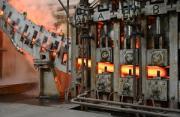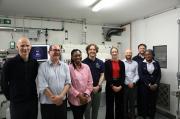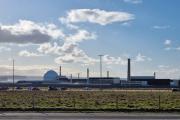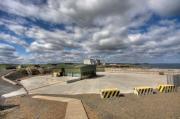
This site uses cookies, by continuing to use this site you accept the terms of our privacy policy
Feed 2.0 Loading...
Public Has Spoken On Options For Dealing With Particles In Marine Environment
28th March 2007
The second stage of consultation on the options for dealing with radioactive particles in the marine environment has come to a close.
The consultation focussed on the relative importance of the criteria used to assess the 11 combined options identified by a scoring panel as most likely to succeed following the first round of consultation.
Exhibitions were held in Thurso, Reay, Castletown and Wick to provide members of the public a chance to see the progress being made in identifying the best practical environment option (BPEO). Seventy-three people visited the exhibitions with a further 64 taking part in a series of workshops which involved members of the Dounreay Stakeholder Group, staff and contractors, high school and college students, local people living in the Caithness and North Sutherland area and those who live out with the area. Seventy written responses were also received from members of the public.
Phil Cartwright, UKAEA's particles and contaminated land manager said "We have done a large amount of technical work over the last year to ensure we continue to improve our knowledge of the extent of the contamination. We recognise, however, that the community is affected by this and it was important to ensure that factual information was made available so that people could come to their own view. It has been very interesting listening to these views and pleasing that everyone who took part, whether it be in the discussion groups at the exhibitions or by questionnaire, made points which we will now take forward and consider.
"Over the next few months the preliminary BPEO will be developed and made available for further public comment before UKAEA makes a recommendation to Scottish Environment Protection Agency (SEPA) and the Nuclear Decommissioning Authority in early 2008."
Meanwhile work continues on measuring the extent of the particle contamination offshore at Dounreay using a remotely operated vehicle. Following the 2005 and 2006 seabed campaigns plans are being prepared for further monitoring and mapping of the seabed.
During the summer months a further survey will be carried out between the old, disused discharge pipeline and West Brims to gain further knowledge on the extent of the main particle plume. Mapping of particles will also take place between the old discharge pipeline, the Dounreay foreshore and Sandside bay to determine particle numbers, their radioactive content and how deeply these are buried in the sediment. The work at Sandside bay is part of the mapping programme initiated in 2005.
Since 1997, 450,000 square metres of the seabed has been surveyed using a towed radiation detection system and divers have spent approximately 1500 hours mapping approximately 500,000 square metres of seabed and retrieved 929 particles in the process. In recent years diving activities have been replaced by a remotely operated vehicle (ROV) equipped with sensitive radiation detection, which has surveyed over 200,000 square metres and identified a further 204 particles in the main plume.
Phil Cartwright added; "It is important to continue with this work to further improve our understanding of where the main concentration of particles lies. Since we have started mapping particles we have not detected any particles beyond a sea depth of 30 metres but that does not mean they are not there. With the dynamics of the sea and the relative calm of the seabed beyond the 30m depth mark it is possible that particles further out there are buried so deeply within the sediment that they are unlikely to return to shore. What we need to do is identify the main particle plume where particles are being transported towards the beaches."
"We are determined to make substantial progress over the next year so we are in a position to implement an environmentally and publicly acceptable on-shore and off-shore option to clean up this problem."
Offshore Particles Remediation
Particle Finds
Main Particles Web Page At UKAEA Dounreay
SEPA Dounreay Particles Advisory Group: 3rd Report - November 2006
Related Businesses
Related Articles
10/1/2025
Fusion-grade Steel Produced At Scale In UK-first
Researchers achieve 10x production cost savings for reduced activation steel. A United Kingdom Atomic Energy Authority (UKAEA) working group has successfully demonstrated the industrial scale production of fusion-grade steel.
22/12/2024
UKAEA To Lead The Creation Of A Robotics And AI Cluster
UKAEA will lead the creation of a new £4.9m nuclear robotics and artificial intelligence cluster across Cumbria and Oxfordshire. The robotics and AI cluster was announced by UK Research and Innovation (UKRI) as one of seven new projects to kickstart economic growth and address regional needs: www.ukri.org The robotics and AI cluster will link Cumbria and Oxfordshire to accelerate the decommissioning of the UK's legacy nuclear fission facilities and keep people out of hazardous environments.
5/12/2024
Diamonds Are Forever? World-first Carbon-14 Diamond Battery Made In Uk
The world's first carbon-14 diamond has been produced with the potential to provide power for thousands of years. Scientists and engineers from the UK Atomic Energy Authority (UKAEA) and the University of Bristol have successfully created the world's first carbon-14 diamond battery.
4/11/2024
UKAEA Monthly Newsletter Latest Edition
Find out what has been happening at UKAEA in our monthly newsletter. Read about our recent activities and upcoming events.
1/10/2024
UKAEA Newsletter - Edition 11 Published Today
Find out what has been happening at UKAEA in our monthly newsletter. Read about our recent activities and upcoming events.
23/5/2024
Corwm Visits Dounreay Nuclear Site
Members were given an overview of the scale of the problem and challenges faced in the decommissioning of the site. In the last week of March 2024, several members of CoRWM led by the Chair, Sir Nigel Thrift, made the long journey up to the North of Scotland to visit the Dounreay nuclear site, now managed by Nuclear Restoration Services.
5/3/2021
Design Contract Awarded For Dounreay Shaft And Silo Work
Dounreay has awarded an important waste clean-up contract to Jacobs as the site plans for the future of its deepest historic radioactive waste store. Jacobs and its supporting partners have been awarded a 6-year contract to provide a design management team to produce a fully integrated design for the shaft and silo project.
6/11/2013
Radiation dose to public from Dounreay reduces
Dounreay�s radioactive impact on the environment continues to fall, according to a report. The annual survey report �Radioactivity in Food and the Environment� (RIFE 2012) has recently been published and it can be read here - http://www.sepa.org.uk/radioactive_substances/publications/rife_reports.aspx The report uses data obtained from samples of air, fresh water, grass, soil, and locally sourced meat, fish, milk and vegetables during 2012.
6/4/2012
57,000 Tonnes Of Hazardous Materials Finally Dealt With At Dounreay
Dounreay today completed the destruction of one of the most hazardous legacies of Britain's earliest atomic research. A purpose-built chemical plant processed the last of 57,000 litres of liquid metal lifted from the primary cooling circuit of the experimental fast breeder reactor.24/3/2011



